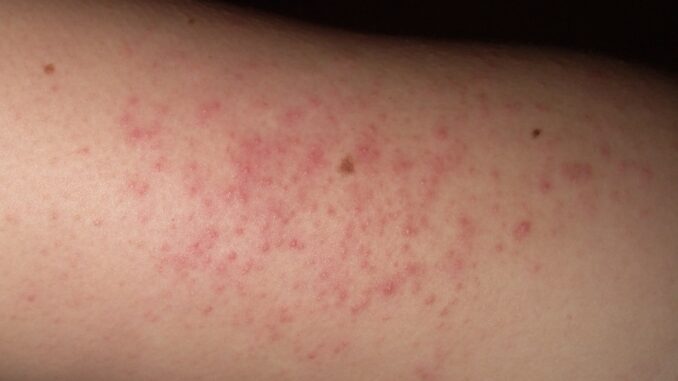
Do you know those tiny bumps that you might have on the backs of your arms? Bumps that would last and are often coupled with random dry patches too? Well, there’s a name for them, Keratosis Pilaris, and while they’re not harmful, many people would prefer they weren’t there. Some would even avoid strappy tops even in warm weather. So, let’s dig into their backstory a little to find out more about Keratosis Pilaris, why they exist, and what you can do to treat them.
What do you need to know about Keratosis Pilaris?
Keratosis is the excess of the top layer of the skin causing it to thicken up. Pilaris refers to the piler unit or the hair portion of the skin. Therefore, Keratosis Pilaris means the buildup of skin in the hair follicle. Keratosis pilaris is a common dry skin condition and it tends to occur because the hair follicles that we have on our arms, or our thighs, the common places that you tend to get it, have skin cells that are not turning over properly. So, what ends up happening is the skin cells block the hair follicles themselves. Hence, you get a little bit of scaling and lumpiness as a result.
Now, the main causes of Keratosis Pilaris are genetic. It’s in your DNA so, you probably inherited it. There’s some genetic basis and foundation that’s causing the abnormal keratinization of the hair follicle. This hair follicle gets this buildup of skin cells on it, and we call it hyperkeratosis. There has been an association with the filaggrin mutation. It’s the same thing that is mutated in patients with eczema. So, you might see that one person has one and they’re more likely to have another one. There’s an overlap between eczema, atopic dermatitis, and keratosis Pilaris. So, we often treat them a little bit similar and a little bit different in some ways. It’s important to keep that in mind when you’re treating this because if you have eczema, some things may irritate your skin when using products to treat Keratosis Pilaris.
What are the Causes of Keratosis Pilaris that we Might be Doing Ourselves?
Often, if you’re using harsh soaps on the skin, they can very much dry the skin out. So, when you’re managing and looking after the skin it’s important that you use gentle cleansers, ideally fragrance-free to stop the skin from drying itself out. The second thing that you’d probably find is as the seasons change particularly when you go into the winter months. It is when it’s colder and you put the central heating on and take hot baths, that causes the skin to dry out further.
Who’s at Risk?
Keratosis pilaris can affect people of any age, race, and sex. It is more common in females.
Keratosis pilaris often develops by age 10 and can worsen during puberty. However, it frequently improves or even goes away by early adulthood.
Keratosis pilaris can affect 50–80% of teenagers and up to 40% of adults. Many people have a family history of keratosis pilaris. A large number of individuals with ichthyosis Vulgaris also report the presence of keratosis pilaris.
How to Treat Keratosis Pilaris on Arms?
Little Keratin builds up around the hair follicle plugging it and giving those scaly red bumps that you see in your skin. They can go from just bland looking and scaly to redder and more inflamed and scalier if you get a lot of inflammation around that hair follicle that’s being plugged by keratin. To get rid of this, we have to try to break up some of that keratin that’s blocking that hair follicle. But you have to keep in mind that a lot of people have an overlap with eczema, so moisturizing is also very important. So, as we treat it, we break down keratin and we also got to moisturize at the same time. With that in mind, here are some ways to treat Keratosis Pilaris:
These are the three ingredients you want to look for when treating your Keratosis Pilaris:
1. Salicylic Acid can get into that hair follicle and break down keratin. It is an exfoliating agent. It doesn’t have moisturizing properties. So, salicylic acid needs to be combined with other moisturizing ingredients like ceramides to get that effect that we want in Keratosis Pilaris.
2. Amlactin, Ammonium Lactate, or Lactic Acid does have moisturizing properties in and of itself. So, Ammonium Lactate in a moisturizer can be very effective for treating Keratosis Pilaris.
3. Urea, at certain concentrations, is where it makes a big difference. This is one of those ingredients where it’s going to be beneficial to pay attention to some of the fine details in products. Less than 10%, urea just works as a moisturizer. Interestingly, it has some humectant properties, and then you cross that threshold, and it starts to work as a keratolytic. It means that it breaks down some of the excess top layers of the skin. So, we’re looking for urea greater than 10% to get that effect.
Some other treatments might be useful to lessen the appearance of Keratosis Pilaris.
Another ingredient that’s been shown effective is topical retinoids. Topical Retinoids help to turn skin cells over. It helps to flatten out that top layer of the skin called the stratum corneum. Thus, it will help with a lot of that keratin that’s building up around the follicle. It will help to reduce redness, erythema, irritation, and inflammation because it helps smooth out the skin. Nevertheless, the issue with retinoids is that if you don’t moisturize before and after applying this, you’re going to run into concerns with irritation especially if you’re somebody that has eczema.
Next, if you moisturize improperly, looking after the skin, the scaling will reduce, and you might find that you’ve got red bumps or just redness or flat red areas left behind. Laser treatments like pulsed dye laser or light-based devices like intense pulsed light can be quite good at shrinking down the blood vessels on the skin and reducing the redness that might be there. It’s important that you get the diagnosis right. That’s the first thing. The second thing is to make sure your expectations are set correctly because if the problem is the dryness and the scaling, the laser and the light will not help that.












Enjoyed every bit of your article.Really thank you! Really Cool.